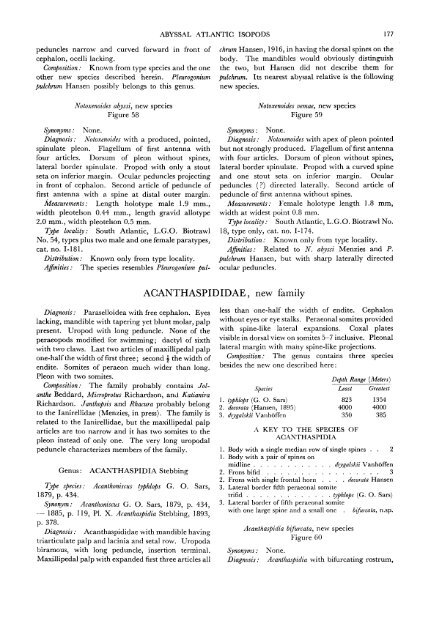The Isopods of Abyssal Depths in the Atlantic Ocean
The Isopods of Abyssal Depths in the Atlantic Ocean
The Isopods of Abyssal Depths in the Atlantic Ocean
Create successful ePaper yourself
Turn your PDF publications into a flip-book with our unique Google optimized e-Paper software.
peduncles narrow and curved forward <strong>in</strong> front <strong>of</strong><br />
cephalon, ocelli lack<strong>in</strong>g.<br />
Composition: Known from type species and <strong>the</strong> one<br />
o<strong>the</strong>r new species described here<strong>in</strong>. Pleurogonium<br />
pulchrum Hansen possibly belongs to this genus.<br />
Notoxenoides abyssi, new species<br />
Figure 58<br />
Synonyms: None.<br />
Diagnosis: Notoxenoides with a produced, po<strong>in</strong>ted,<br />
sp<strong>in</strong>ulate pleon. Flagellum <strong>of</strong> first antenna with<br />
four articles. Dorsum <strong>of</strong> pleon without sp<strong>in</strong>es,<br />
lateral border sp<strong>in</strong>ulate. Propod with only a stout<br />
seta on <strong>in</strong>ferior marg<strong>in</strong>. Ocular peduncles project<strong>in</strong>g<br />
<strong>in</strong> front <strong>of</strong> cephalon. Second article <strong>of</strong> peduncle <strong>of</strong><br />
first antenna with a sp<strong>in</strong>e at distal outer marg<strong>in</strong>.<br />
Measurements: Length holotype male 1.9 mm.,<br />
width pleotelson 0.44 mm., length gravid allotype<br />
2.0 mm., width pleotelson 0.5 mm.<br />
Type locality: South <strong>Atlantic</strong>, L.G.O. Biotrawl<br />
No. 54, types plus two male and one female paratypes,<br />
cat. no. 1-181.<br />
Distribution: Known only from type locality.<br />
Aff<strong>in</strong>ities: <strong>The</strong> species resembles Pleurogonium pul-<br />
Diagnosis: Paraselloidea with free cephalon. Eyes<br />
lack<strong>in</strong>g, mandible with taper<strong>in</strong>g yet blunt molar, palp<br />
present. Uropod with long peduncle. None <strong>of</strong> <strong>the</strong><br />
peraeopods modified for swimm<strong>in</strong>g; dactyl <strong>of</strong> sixth<br />
with two claws. Last two articles <strong>of</strong> maxillipedal palp<br />
one-half <strong>the</strong> width <strong>of</strong> first three; second \ <strong>the</strong> width <strong>of</strong><br />
endite. Somites <strong>of</strong> peraeon much wider than long.<br />
Pleon with two somites.<br />
Composition: <strong>The</strong> family probably conta<strong>in</strong>s Jolan<strong>the</strong><br />
Beddard, Microprotus Richardson, and Katianira<br />
Richardson. Janthopsis and Rhacura probably belong<br />
to <strong>the</strong> Ianirellidae (Menzies, <strong>in</strong> press). <strong>The</strong> family is<br />
related to <strong>the</strong> Ianirellidae, but <strong>the</strong> maxillipedal palp<br />
articles are too narrow and it has two somites to <strong>the</strong><br />
pleon <strong>in</strong>stead <strong>of</strong> only one. <strong>The</strong> very long uropodal<br />
peduncle characterizes members <strong>of</strong> <strong>the</strong> family.<br />
Genus: ACANTHASPIDIA Stebb<strong>in</strong>g<br />
Type species: Acanihoniscus typhlops G. O. Sars,<br />
1879, p. 434.<br />
Synonym: Acanthoniscus G. O. Sars, 1879, p. 434,<br />
— 1885, p. 119, PI. X. Acanthaspidia Stebb<strong>in</strong>g, 1893,<br />
p. 378.<br />
Diagnosis: Acanthaspididae with mandible hav<strong>in</strong>g<br />
triarticulate palp and lac<strong>in</strong>ia and setal row. Uropoda<br />
biramous, with long peduncle, <strong>in</strong>sertion term<strong>in</strong>al.<br />
Maxillipedal palp with expanded first three articles all<br />
ABYSSAL ATLANTIC ISOPODS 177<br />
chrum Hansen, 1916, <strong>in</strong> hav<strong>in</strong>g <strong>the</strong> dorsal sp<strong>in</strong>es on <strong>the</strong><br />
body. <strong>The</strong> mandibles would obviously dist<strong>in</strong>guish<br />
<strong>the</strong> two, but Hansen did not describe <strong>the</strong>m for<br />
pulchrum. Its nearest abyssal relative is <strong>the</strong> follow<strong>in</strong>g<br />
new species.<br />
Notoxenoides vemae, new species<br />
Figure 59<br />
Synonyms: None.<br />
Diagnosis: Notoxenoides with apex <strong>of</strong> pleon po<strong>in</strong>ted<br />
but not strongly produced. Flagellum <strong>of</strong> first antenna<br />
with four articles. Dorsum <strong>of</strong> pleon without sp<strong>in</strong>es,<br />
lateral border sp<strong>in</strong>ulate. Propod with a curved sp<strong>in</strong>e<br />
and one stout seta on <strong>in</strong>ferior marg<strong>in</strong>. Ocular<br />
peduncles (?) directed laterally. Second article <strong>of</strong><br />
peduncle <strong>of</strong> first antenna without sp<strong>in</strong>es.<br />
Measurements: Female holotype length 1.8 mm,<br />
width at widest po<strong>in</strong>t 0.8 mm.<br />
Type locality: South <strong>Atlantic</strong>, L.G.O. Biotrawl No.<br />
18, type only, cat. no. 1-174.<br />
Distribution: Known only from type locality.<br />
Aff<strong>in</strong>ities: Related to N. abyssi Menzies and P.<br />
pulchrum Hansen, but with sharp laterally directed<br />
ocular peduncles.<br />
ACANTHASPIDIDAE, new family<br />
less than one-half <strong>the</strong> width <strong>of</strong> endite. Cephalon<br />
without eyes or eye stalks. Peraeonal somites provided<br />
with sp<strong>in</strong>e-like lateral expansions. Coxal plates<br />
visible <strong>in</strong> dorsal view on somites 5-7 <strong>in</strong>clusive. Pleonal<br />
lateral marg<strong>in</strong> with many sp<strong>in</strong>e-like projections.<br />
Composition: <strong>The</strong> genus conta<strong>in</strong>s three species<br />
besides <strong>the</strong> new one described here:<br />
Depth Range (Meters)<br />
Species Least Greatest<br />
1. typhlops (G. O. Sars) 823 1354<br />
2. decorata (Hansen, 1895) 4000 4000<br />
3. drygalskii Vanh<strong>of</strong>fen 350 385<br />
A KEY TO THE SPECIES OF<br />
ACANTHASPIDIA<br />
1. Body with a s<strong>in</strong>gle median row <strong>of</strong> s<strong>in</strong>gle sp<strong>in</strong>es . . 2<br />
1. Body with a pair <strong>of</strong> sp<strong>in</strong>es on<br />
midl<strong>in</strong>e drygalskii Vanh<strong>of</strong>fen<br />
2. Frons bifid 3<br />
2. Frons with s<strong>in</strong>gle frontal horn . . . . decorata Hansen<br />
3. Lateral border fifth peraeonal somite<br />
trifid typhlops (G. O. Sars)<br />
3. Lateral border <strong>of</strong> fifth peraeonal somite<br />
with one large sp<strong>in</strong>e and a small one . bifurcata, n.sp.<br />
Acanthaspidia bifurcata, new species<br />
Figure 60<br />
Synonyms: None.<br />
Diagnosis: Acanthaspidia with bifurcat<strong>in</strong>g rostrum,

















